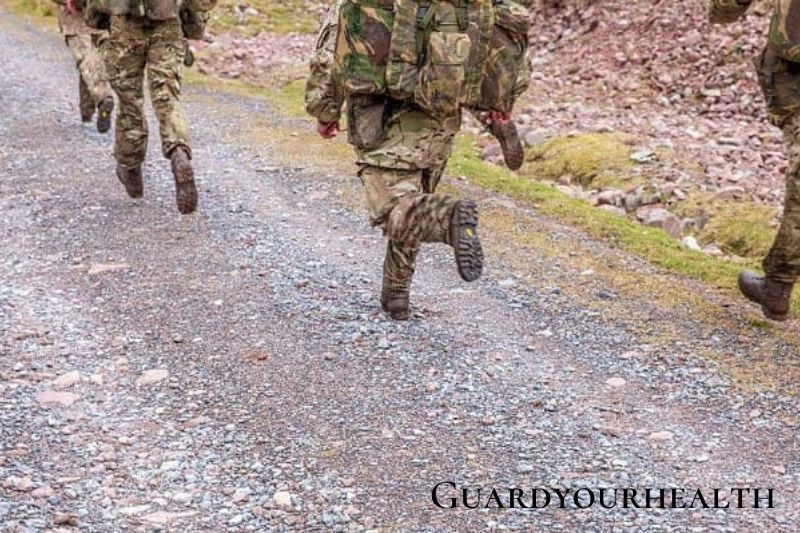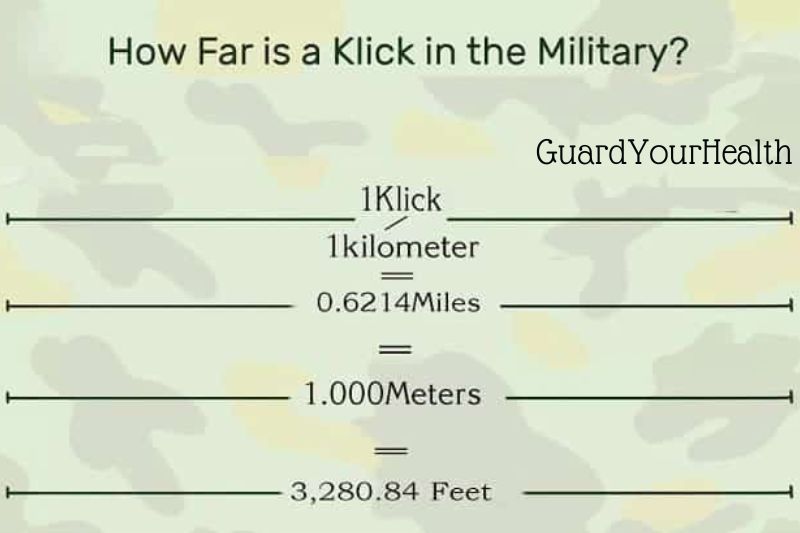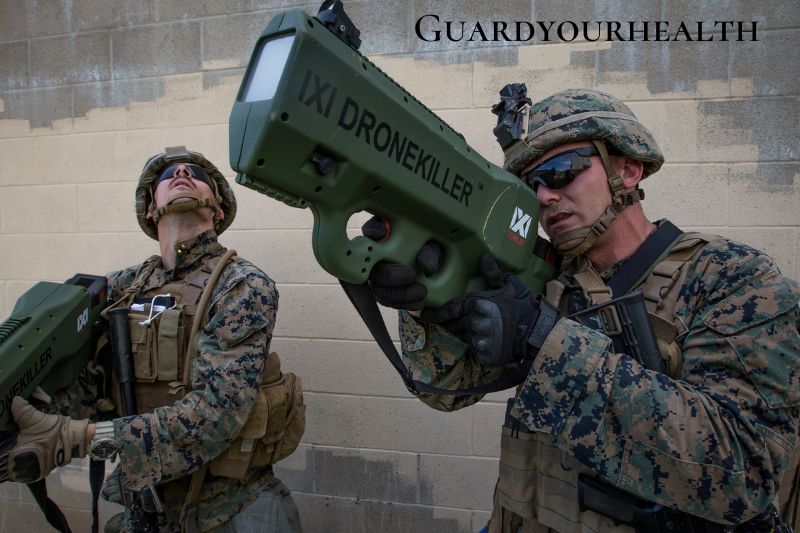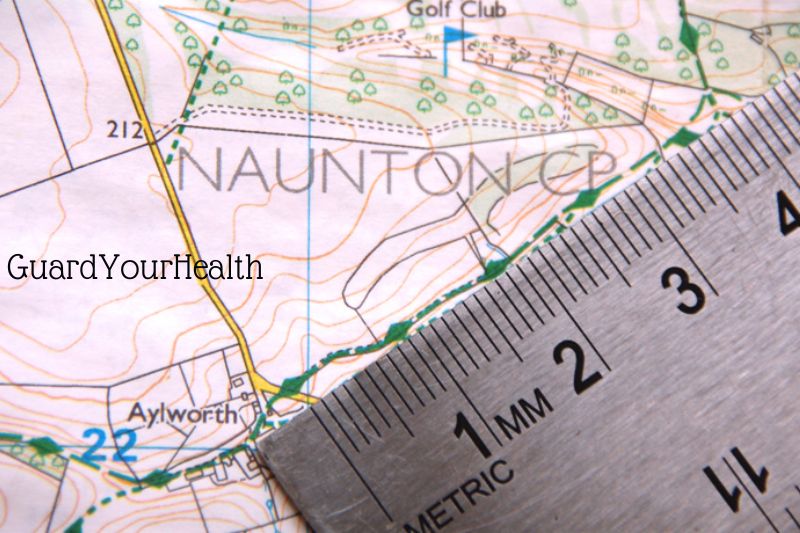A klick is a unit of measurement in the military. It is equal to one-thousandth of a nautical mile, or approximately 1. 1 statute miles. The klick is used by the U. S. military, as well as some other militaries around the world.
So how far is a klick in military distance and why the Us military uses Klicks?
Let’s be with GuardYourHealth to answer these questions and get more useful information.
What Is A Klick In Military Terms?
Klick, as opposed to click, is a term used in the military to describe a minute of arc while a person is sighting in a weapon. Since rifle rounds do not move in a straight line, this term is most frequently associated with rifle sighting.
Rather, gravity will cause the motion to take the form of an arc. The process of adjusting the shooter’s sight to strike the target at a specific range is referred to as sighting-in. For instance, a soldier might see their gun hitting a target at 200 yards.
What Is The History of The Word Klick?
Although the word’s actual origins are unknown, some historians suggest that the Australian military may have come up with the term in Vietnam. Infantry men would pace to gauge each distance while using a compass to follow orders.
Each soldier would count their steps, and 100 meters were equal to 110 paces on level ground, 120 paces uphill, and 100 paces downhill. Every 100 meters was regarded as a “mark” by them.
Soldiers would raise their gun and shift the gas regulator with their thumb to signal to their commander that they had moved 1,000 meters, which the commander could hear as a “click.” The word “klick” is thought to have come from this click.
How Far Is A Click Military?
The military uses the term “klick” to refer to 1,000 meters, one kilometer, 0.6214 miles, or 3,280.84 feet. The metric system uses kilometers as the unit of measurement for describing the length of a specific distance.
Around the world, we usually use kilometers to indicate certain distances; but in the United States and some regions of the United Kingdom, we use miles instead of kilometers.
Since World War I when they fought alongside the French, who employed the metric system to calculate distances, the United Kingdom and the United States have used metric systems in a variety of operations. The word “kilometer” has been regularly employed in American military jargon since working with the French.
Since the organization’s founding, all maps used by NATO members have been compliant with the NATO Standardization Agreements. Military members of NATO can find numerous spots on the planet within one meter using their own mapping system. Additionally, this method measures in kilometers, or klicks.
Why Does the US Military Use Klicks?
The United States Army uses the metric system even though most Americans do not because there are several joint operations and communications with other nations that do not use the imperial system.
The United States, Myanmar, and Liberia are the only three nations in the world that are thought to still operate under the imperial system. As a result, American service members stationed abroad must become accustomed to the more widely used metric system.
Consequently, klick—a unit of measurement for kilometers—emerged in the military. Klick is preferred over the word “kilometer” since it is shorter and simpler to pronounce.
This measurement can be used and understood by military people everywhere. This widespread application avoids misunderstandings and errors in judgment when carrying out military tasks and/or combat actions.
Military radios and other communication devices frequently use Klick. Additionally, using 1 km by 1 km grid squares on military maps fits well with using klicks. Locating sites with klicks is also more precise for service members.
Additionally, it is simple to translate klicks into meters, which is the preferred measurement unit for most foreign maps, particularly those depicting landscapes and/or terrains with measured elevation contour lines.
Non-Military Uses of “Click”
When sighting a weapon, such as a rifle, the phrase “click”—spelled with a “c” rather than a “k“—is used in military jargon. In other terms, one “click” on most weapons equals one minute of arc or one inch of distance at 100 yards.
In other words, altering the rifle’s site adjustments by “one-click” will modify the point of contact for a target by one inch at 100 yards, two inches at 200 yards, and so on.
One Minute of Angle (MOA) at 100 yards is actually a little bit more than one inch for the meticulous. (There are 360 degrees in a circle, and each degree is divided into 60 minutes.)
At 100 yards, one-degree measures 62.83 inches, rounded to the nearest 1/100 of an inch. One MOA, or 1/60 of that, is 1.047 inches; nonetheless, rounding is convenient for making quick calculations. The phrase is derived from the clicking noise generated when turning the sight adjusting knobs.
What Are Other Common Military Distance Measurements?
Several of the most typical distance measurement types employed by various military branches include the following:
A nautical mile is a unit of measurement used for defining territorial seas and space, aviation, and maritime navigation. On the circle of the planet, one nautical mile is equivalent to 1.852 kilometers or 1,852 meters. In terms of latitude, it is also equal to one minute.
In aviation and nautical military branches, a knot is a unit of distance measurement that designates a speed equal to one nautical mile per hour, or 1.852 kilometers per mile.
Kiloyard: In length, a kiloyard is one thousand yards or 914.4 meters. Although it is no longer commonly used, some military branches continue to refer to 1,000 yards as a kiloyard.
Velocity is a phrase used to define how fast a projectile—such as a pellet, bullet, or slug—moves relative to the muzzle when it exits the gun’s barrel. The Army widely uses this measurement method to describe the capabilities of various weapon systems.
The velocity of an artillery cannon, for instance, is low when it is less than 762 m/s and high when it is between 914 m/s and 1,067 m/s. When the velocity is between 472 m/s and 1,021 m/s, tank guns have a high velocity.
Vertical lines that converge at the North and South Poles of the globe are said to be longitudes. The location at an angle between north and south through the Prime Meridian and a vertical point is represented by a place’s longitude.
Latitude: The horizontal axes that follow the equator are referred to as latitude. Each degree that makes up a latitude is approximately 69 miles long.
Furlong: A furlong is an example. 220 yards, or 125 of a mile.
Rod: An old English unit of measurement known as a “rod” is occasionally used in the military to designate a distance equal to 16.5 feet or 5.5 years.
Today’s Use of Klick in the Military
Regardless of its past, klick has cemented its place in the modern military lexicon. Due to the necessity of speedy and accurate information transfer in radio communication devices, this application is where it is most frequently seen.
Klicks are perfect for conveying messages because of their concise form and simple pronunciation, eliminating three syllables.
FAQs About Military Distance Click
How Far Is A Klick In Miles?
0.6214 miles
The military uses the term “klick” to refer to 1,000 meters, one kilometer, 0.6214 miles, or 3,280.84 feet. The metric system uses kilometers as the unit of measurement for describing the length of a specific distance.
How Many Yards Is A Click?
1 click = 1 minute of arc or 1 inch at a distance of 100 yards.
In other words, changing a gun’s sights by one “click” will change the impact of the bullet on a target 100 yards away by one inch.
Why Does The Military Say Clicks Instead Of Miles?
According to the hypothesis, a mechanism would alert soldiers every 100 meters to increase the gas regulation on their guns. The gas regulator makes a clicking noise as it returns to its starting position after 10 pushes. Creating the word “klick” for a kilometer in the process.
Conclusion
You should now be familiar with this phrase’s definition and its conversion, etymology, and current use.
You may be confident that if you are a soon-to-be military member, you won’t be taken aback if the term “klick” refers to you during missions or training.
Hopefully, this was of use. Please do not hesitate to leave us a remark if you have any more queries or ideas. We enjoy speaking and listening to our readers.








